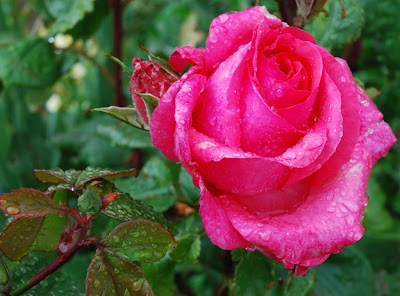Flowers in the Rain at Topsham
If it hadn't been for the rain you wouldn't be admiring this
image of a glistening, tear-dropped red rose which I found in one of Topsham's secret
gardens yesterday.
Or its diamond-clustered deeply blushing pink near-neighbour.
Or yet another image of the same one which I didn't have the
heart to cut out. Just showing off really.
And gardening expert Veitch enthusiast Caradoc Doy wouldn't have been able to demonstrate how if you rub the soaking flowers of this magnificent ceanothus between your hands it'll be almost exactly as if you were holding a bar of soap. The foam that comes from this novel form of hand-washing is caused by the saponin contained in the plant, a substance found in many other specimens of the secret world of plants.
It's true - I checked it out and found http://www.independent.co.uk/news/education/education-news/gardening-keen-to-be-clean-as-well-as-green-heres-how-to-grow-your-own-soap-1295444.html
If it hadn't been for the rain Friend of Fairlynch Margaret
Wilson wouldn't have been holding this umbrella as she greeted visitors at Topsham Museum 's
Secret Garden
The rain, it has to be said, was torrential at times.
Margaret, Head Gardener at Topsham
Museum
Still, you can't have everything. The rain's what makes Devon so green, and our own rhododendrons in Budleigh
Salterton are looking so much happier now that the water-butts are full again
after that short-lived heatwave in May.
At least the stormy Atlantic gales had blown themselves out.
A windswept herbaceous border is a sad sight, and a fine notice like this one
advertising the event might well have disappeared into the River Exe flowing at
the bottom of the Museum garden. 'Daisies', the painting used in the design of the notice, is the work of local artist Sarah Gillard http://www.sarahgillard.com/
And I learnt interesting stuff from Caradoc, including the
fact that the leaves from a crab apple tree in the Museum's garden, originally
from China and imported by the English plant hunter Ernest Wilson in 1900, were used by
peasant workers to make a form of tea. The tree, Malus hupehensis, also known as the 'Tea crab apple' is now so rare in its
homeland that there are many more growing in the UK than in China.
More information can be found by clicking on http://www.caradocdoy.co.uk/
And people were so friendly. The British seem to be that
much more inclined to talk to strangers in a downpour, as if we feel that the
rain's our common enemy and a good chat, especially over a cup of tea, is the
best way of dealing with it.
So that was why, perhaps, I found myself engrossed for a
time, bizarrely, in an absorbing conversation about sponges, flint, salt,
foraminifera and other arcane matters with a Topsham resident, a professor
of Geological Sciences whom I met by chance in one of the first gardens we visited.
That in itself would have made my day because the professor
was kind enough to offer help in planning our 'Sea, Salt and Sponges' exhibition
at Fairlynch next year, a tribute to Henry John Carter (1813-95), Budleigh's own Fellow of the Royal Society.
Later in the afternoon the rain almost stopped and the
gardens at times were almost full of visitors. So here are some more photos
showing that we had a wonderful time discovering that there is indeed a secret
world of flowers, shrubs, and even quite exotic fruit and vegetables growing in
the shelter of the often sun-baked old brick walls of ancient Topsham.

In the same garden was another rose with teardrops in the
rain which caught my eye - white with beautiful shades of yellow this
time.
There was quite a variety of gardens on display.
Finding this communal garden at Strand Court
But I wish I'd been able to identify this pretty pink
herbaceous border plant.
And this iris-like blue flower also foxed me. Any ideas out
there?
But I know that this is a beautiful cistus, looking even
more fetching in the rain.
And this, I think, could be a variety of Escallonia called
'Apple blossom' which I lost in the Northamptonshire frosts many years ago.
Quite a number of the Topsham gardens were communal and
charmingly intimate, shared between different cottages. At Clara Place
And at 20 Ferry Road where there are two contrasting small
gardens belonging to Flats 3 and 4 I admired this acer which looks like the
roof of a thatched cottage.
By contrast there was the large Victorian garden of Grove Hill House
At the garden
of Globe
Of course, teas with scones and cakes were being served here
at 21 Victoria Road Strand .
Raindrops were falling on my head as I watched flowers in
the rain, feeling the power of flowers in my head and thinking of so many songs
and poems inspired by our damp British climate including 60s' rock musicians.
And quite pleased with some of the photos I'd taken.
And the Museum? Well,
a few cowardly souls who couldn't face getting a little bit wet had taken refuge
there and I thought I'd better see what they offer.
"Wow!" I thought when I saw this splendid gallery
which rather understatedly they call The Loft. Definitely Topsham Museum
For more information about Topsham Museum
Share my Garden has left a new comment on your post "Garden news from Topsham Museum":
Have found your site following from a pleasant visit to the museum on Saturday, (delicious cake!) I do hope that you will repeat the open gardens event next year and if so will let me know the date.
We have a scaffolding tower - one of the most useful things that we have bought. I hope that you concentrate and don't play around too much when you are on it!
Share my Garden has left a new comment on your post "Garden news from Topsham Museum":
Have found your site following from a pleasant visit to the museum on Saturday, (delicious cake!) I do hope that you will repeat the open gardens event next year and if so will let me know the date.
We have a scaffolding tower - one of the most useful things that we have bought. I hope that you concentrate and don't play around too much when you are on it!






















Comments
Post a Comment